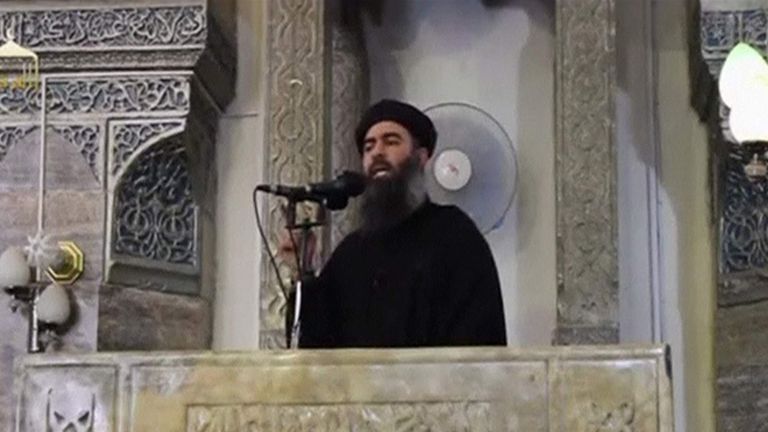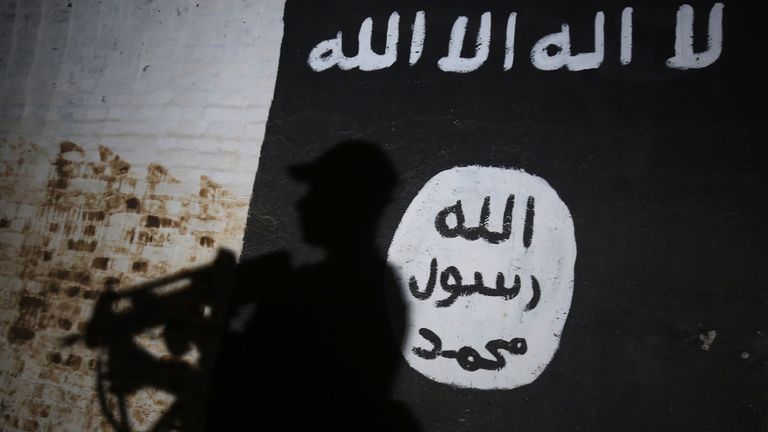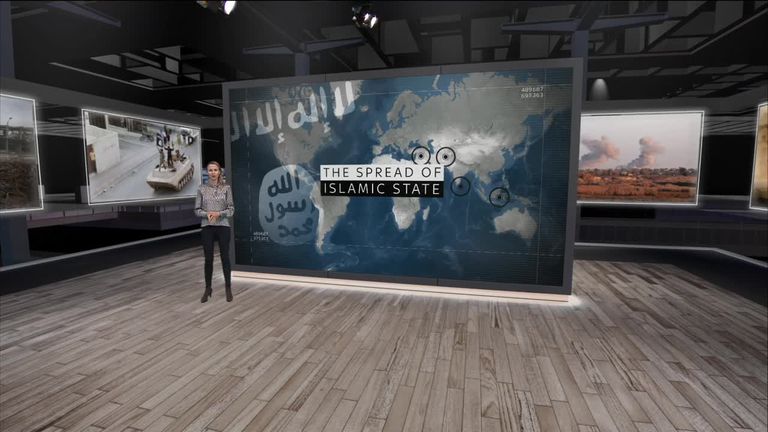What do we know about Abu Bakr al Baghdadi?
The Islamic State leader has overseen the rise and fall of the terror group in Iraq and Syria.
Tuesday 29 October 2019 09:35, UK
The international manhunt for the leader of Islamic State has finally drawn to a close.
Abu Bakr al Baghdadi has been killed in a US operation in Syria, the president has said.
So who is the notorious leader, and what impact did he have?
Where is he from?
Al Baghdadi was born Ibrahim Awwad Ibrahim Ali al-Badri al-Samarrai in 1971 in Samarra, Iraq.
He was detained by US forces in Iraq in February 2004 and sent to Bucca prison over anti-US militant activity.
However he was released 10 months later after being seen as a low-level threat.
Al Baghdadi then joined the Iraqi branch of terror group al Qaeda, which later became the Islamic State of Iraq, and al Baghdadi assumed control.
:: Listen to the Daily podcast on , , ,
Under al Baghdadi's watch, the Islamic State of Iraq merged with another group, the Nusra Front.
Al Baghdadi has led the Islamic State for the last five years, overseeing its rise to a self-styled caliphate in Iraq and Syria - and its subsequent fall.
The self-proclaimed "caliph" was last seen in 2014 in the pulpit of the Nouri mosque in Mosul, urging Muslims around the world to swear allegiance to the caliphate.
Previous reports of his death
There have been multiple reports of al Baghdadi's death previously which have turned out to be untrue.
He was reportedly severely injured in an airstrike in Iraq in 2015.
In 2017, Russia's military claimed it had killed the Islamic State leader in an airstrike.
But US Defence Secretary General Jamis Mattis later said he believed al Baghdadi was still alive.
The rise and fall of the Islamic State
The Islamic State originated in Iraq following the US invasion in 2003.
Following the removal of Saddam Hussein's regime, a number of groups emerged in an attempt to seize control of the territory.
One of these was the Islamic State of Iraq, then led by Abu Omar al Baghdadi.
After the former leader was killed in a US-led operation, he was succeeded by Abu Bakr al Baghdadi.
Al Baghdadi recruited several ex-members of Saddam Hussein's officer corps, and also sent fighters across the border in Syria to make alliances with the various groups which had emerged to rebel against President Bashar al Assad during the Arab Spring.
The leader then captured Mosul and Fallujah in Iraq, and Raqqa in Syria, and declared in June 2014 that he had established a caliphate.
At this point, the group became known simply as the Islamic State.
The terror group continued to expand its territory, capturing gas and oil fields and oil refineries and enslaving hundreds of women.
It also captured more territory in Syria, pushing west from Raqqa.
US President Barack Obama ordered airstrikes against the group in Iraq, while Britain and France helped to provide aid to civilians.
According to the US, 79 countries took part in the fight to bring down the Islamic State.
The terror group suffered defeats on the battlefield in 2016 and 2017, losing control of Mosul in July 2017.
US President Donald Trump announced in December 2018 that the Islamic State had been defeated and earlier this month pulled troops out of northeastern Syria.
Now, tens of thousands of Islamic State fighters and their families remain in makeshift prisons in northeastern Syria.
How al Baghdadi shaped the terror group
Al Baghdadi grew the Islamic State from an Iraq-based group to a sprawling self-styled caliphate in Iraq and Syria.
During his five years as leader, the terror group attracted hundreds of thousands of followers and inspired terror attacks across Europe and the US.
Thousands of recruits came from foreign countries, including Russia, Saudi Arabia, Tunisia, France and the UK.
According to research from the International Centre for the Study of Radicalisation (ICSR) in 2014, nearly 41,500 people travelled to Iraq and Syria from 80 countries.
The terror group grew a reputation for beheading western hostages, including journalists James Foley and Steven Sotloff.
It also called for attacks in western countries, often using propaganda videos with a high production value.
The Islamic State claimed to be behind a series of attacks across the US and Europe, including suicide bomb and gun attacks in Paris which killed more than 130 people in 2015, and a nightclub shooting in Orlando, Florida, which killed 49 people in 2016.











